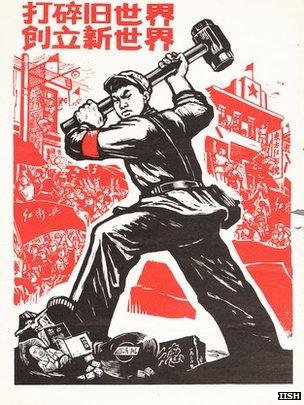500 words from...is a series of guest posts from authors writing about
Asia, or published by Asia-based, or Asia-focused, publishing houses, in which
they talk about their latest books. Jeffrey Wasserstrom is an American
historian of modern China who teaches at the University of California, Irvine. He
edited a fantastic new reference book, the Oxford Illustrated History of Modern
China. Here
he talks about selecting the illustrations.
Several years ago, when I accepted the invitation
to edit the Oxford Illustrated History of Modern China, which is
already available in the UK, and will be out in North America later in the
summer*, I wasn’t sure about many things. One was which colleagues I
would try to convince to write several of the chapters. Another was what
sort of visuals would be included. I did know two things right from the
start, though, related to a topic, the Cultural Revolution, which has been in
the news a lot lately, due to the arrival of the fiftieth anniversary of its
start. I knew I wanted Richard Curt Kraus to write the chapter on the
topic, since he had just finished a slim, smart, and stylish volume on the
Cultural Revolution for Oxford’s Very Short Introductions series. I also
knew that, if he agreed, I’d encourage him to include a few of the period’s
colorful and varied propaganda posters in his chapter.
Fortunately, Kraus
said yes, and had excellent ideas when
it came to posters, with ones that made the final cut including a vibrantly
hued image linked to Mao’s personality cult and a lovely image of a celebrated
locale known for its oil refineries done in the style of a traditional ink
painting.
Readers of the book will not have to wait until
they get to Kraus’s chapter, however, to see Mao era posters. They will
find some in Stephen Smith’s chapter on the 1950s.
Even sooner, they
will see in my Introduction a poster
reproduced that was originally created to accompany the Cultural Revolution
campaign to combat the influence of old ideas and practices. This
poster, in red woodblock print style, draws attention to the mix of
continuities and ruptures between the Mao years and the current moment.
The central figure is an outsized Red Guard militant swinging a
sledgehammer, which he is using to destroy, among other things, a statue of the
Buddha, representing the period’s attack on all traditional forms of religion
and philosophy, and a phonograph record - presumably of Western classical,
jazz, or rock music, all of which were disdained by Maoist militants of the
time as bourgeois and decadent.
If we flash forward to the present, we find that
Mao’s successors no longer take a dim view of traditional philosophy and
religion. Confucius was a major focus of criticism during the Cultural
Revolution, yet now Beijing is setting up institutes named in his honor across
the globe. By contrast, there are echoes of the Mao era in the statements
the authorities periodically make warning about the allegedly pernicious
influence of Western cultural imports. Recently, for example, new
regulations came out requiring Chinese television networks to get special
permission before developing programs based on shows created abroad.
Homegrown entertainment is better, the governing body claimed, in promoting the
so-called China Dream, and socialist values - though it is anyone’s guess what
exactly that latter term means in an era of megamalls, showy supercars, and an
ever greater chasm between rich and poor.
* Check
with booksellers in Asia: some may already stock the book;
others may be waiting for it to publish in the USA.


